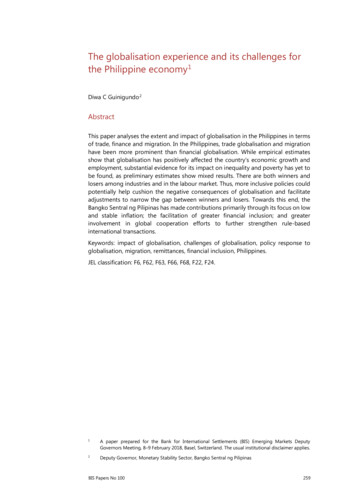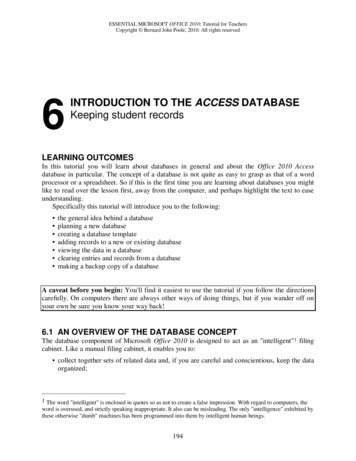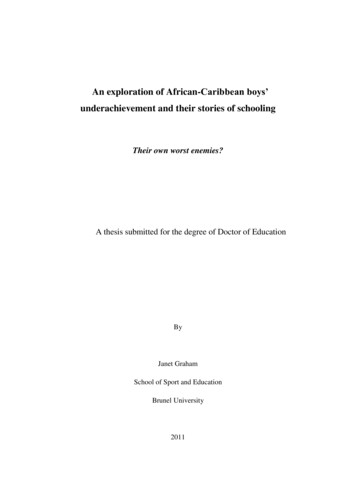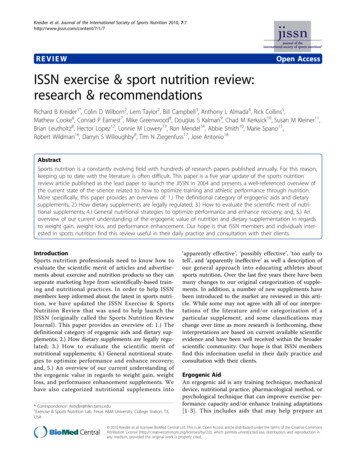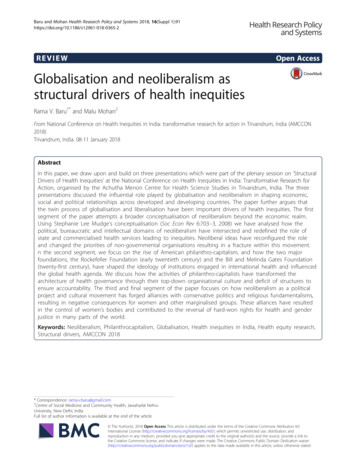
Transcription
Baru and Mohan Health Research Policy and Systems 2018, 16(Suppl EWOpen AccessGlobalisation and neoliberalism asstructural drivers of health inequitiesRama V. Baru1* and Malu Mohan2From National Conference on Health Inequities in India: transformative research for action in Trivandrum, India (AMCCON2018)Trivandrum, India. 08-11 January 2018AbstractIn this paper, we draw upon and build on three presentations which were part of the plenary session on ‘StructuralDrivers of Health Inequities’ at the National Conference on Health Inequities in India: Transformative Research forAction, organised by the Achutha Menon Centre for Health Science Studies in Trivandrum, India. The threepresentations discussed the influential role played by globalisation and neoliberalism in shaping economic,social and political relationships across developed and developing countries. The paper further argues thatthe twin process of globalisation and liberalisation have been important drivers of health inequities. The firstsegment of the paper attempts a broader conceptualisation of neoliberalism beyond the economic realm.Using Stephanie Lee Mudge’s conceptualisation (Soc Econ Rev 6:703–3, 2008) we have analysed how thepolitical, bureaucratic and intellectual domains of neoliberalism have intersected and redefined the role ofstate and commercialised health services leading to inequities. Neoliberal ideas have reconfigured the roleand changed the priorities of non-governmental organisations resulting in a fracture within this movement.n the second segment, we focus on the rise of American philanthro-capitalism, and how the two majorfoundations, the Rockefeller Foundation (early twentieth century) and the Bill and Melinda Gates Foundation(twenty-first century), have shaped the ideology of institutions engaged in international health and influencedthe global health agenda. We discuss how the activities of philanthro-capitalists have transformed thearchitecture of health governance through their top-down organisational culture and deficit of structures toensure accountability. The third and final segment of the paper focuses on how neoliberalism as a politicalproject and cultural movement has forged alliances with conservative politics and religious fundamentalisms,resulting in negative consequences for women and other marginalised groups. These alliances have resultedin the control of women’s bodies and contributed to the reversal of hard-won rights for health and genderjustice in many parts of the world.Keywords: Neoliberalism, Philanthrocapitalism, Globalisation, Health inequities in India, Health equity research,Structural drivers, AMCCON 2018* Correspondence: rama.v.baru@gmail.com1Centre of Social Medicine and Community Health, Jawaharlal NehruUniversity, New Delhi, IndiaFull list of author information is available at the end of the article The Author(s). 2018 Open Access This article is distributed under the terms of the Creative Commons Attribution 4.0International License (http://creativecommons.org/licenses/by/4.0/), which permits unrestricted use, distribution, andreproduction in any medium, provided you give appropriate credit to the original author(s) and the source, provide a link tothe Creative Commons license, and indicate if changes were made. The Creative Commons Public Domain Dedication o/1.0/) applies to the data made available in this article, unless otherwise stated.
Baru and Mohan Health Research Policy and Systems 2018, 16(Suppl 1):91BackgroundThis paper draws upon and builds on the presentations inthe plenary session on ‘Structural Drivers of Health Inequities’ at the National Conference on Health Inequitiesin India: Transformative Research for Action, organisedby the Achutha Menon Centre for Health Science Studiesin Trivandrum, Kerala. It elaborates on how globalisationand neoliberal ideas played a dominant role in reconfiguring economic, social, political and institutional relationships that have profoundly impacted people’s lives.There are many ways in which the term neoliberalismhas been used for analysing its influence on the structureof health services. Much of the scholarly and populist writings have conceptualised neoliberalism as a hegemonicideological project. For a more meaningful analysis, weneed to conceptualise neoliberalism in broader terms. It isessential to go beyond the economic aspects and encompass its effects on political, cultural and social processes.Stephanie Lee Mudge’s [1] conceptualisation of neoliberalism helps us to delineate the processes throughwhich neoliberalism influences health inequities (Fig. 1).According to Mudge, there are three interconnectedfaces, namely the political, bureaucratic and intellectualor academic faces. She points out that considering thecomplex interaction between the three faces is necessaryPage 2 of 29for any analysis of how neoliberalism has impacted theindividual, institutions, culture, social and economic relations. Here, she emphasises how neoliberal economicpolicies are in fact political. As she elaborates:Fig. 1 Mudge’s conceptualisation of neoliberalism. Redrawn from Mudge [1]1. “Neoliberalism’s intellectual face is distinguished by(a) its Anglo-American anchored trans-nationality;(b) its historical gestation within the institutions ofwelfare capitalism and the Cold War divide and (c)an unadulterated emphasis on the (disembedded)market as the source and arbiter of humanfreedoms”.2. “The bureaucratic face is expressed in State policy:liberalisation, deregulation, privatisation,depoliticisation, and monetarism. The family ofreforms is targeted at promoting unfetteredcompetition by getting the State out of the businessesof ownership and getting politicians out of thebusiness of dirigiste–style economic management.Neoliberal policies also aim to ‘desacralise’institutions that have formerly been protected fromthe forces of private market competition, such aseducation and healthcare”.3. “Its political face is a new market-centric ‘politics’,i.e. struggles over political authority that shares a
Baru and Mohan Health Research Policy and Systems 2018, 16(Suppl 1):91particular ideological centre or, in other words, areunderpinned by an unquestioned ‘common sense’.On the elite level, neoliberal politics is bound bycertain notions about the state’s responsibilities (tounleash market forces wherever possible) and thelocus of state authority (to limit the reach of politicaldecision-making). They also tend to be orientedtowards specific constituencies (business, financeand white-collar professionals) over others (tradeunions, especially)” [1].This conceptualisation is useful in describing how thevarious faces of neoliberalism have intersected and redefined the role of the state and society.In the analysis of neoliberalism and health, there is agreat deal of conceptual confusion. A quick review ofIndian studies shows that they pay more attention toneoliberalism as a hegemonic ideological project. Severalstudies have examined how neoliberal policy instruments, such as privatisation, marketisation, commercialisation and deregulation, have led to the expansion ofmarkets in the economic and social sectors [2, 3]. In thecase of the health sector, this has meant the restructuring of the public sector by introducing market principlesand reducing the barriers for movements of capital toinvest in for-profit services. Several studies have identified the critical role played by global multilateralorganisations like the World Bank and the InternationalMonetary Fund (IMF) in furthering neoliberalismthrough the Structural Adjustment Programmes (SAP)in India [2, 4]. Thus, the introduction of SAPs served asthe starting point for critical academic writing on neoliberal reforms in health. An impositional perspective1 tothe engagement of the World Bank and the Indian stateinformed most of these studies [2–5]. This perspectiveargues that the World Bank coerced the Indian government to accept a range of neoliberal conditionalities thatwere tied to the loans. An impositional perspective islimiting because it gives undue importance to the powerwielded by international financial institutions. The Indian government did not passively accept the conditionalities but rather negotiated their terms with the WorldBank. Therefore, one would disagree with the view thatthe World Bank coerced the Indian government, whichdoes not give agency to the Indian state.2It is also important to note that, unlike some countriesin Africa, in the Indian case, neoliberal ideas were incirculation, with opposition and resistance to these ideaseven before their introduction in 1991 [6].3 However, theelite across major political parties and the administration, including the medical and non-medical civilservices, academia and civil society, was in sync with theneoliberal ideology and played an active role in supporting the idea and content of SAPs [5, 7].Page 3 of 29The shifts in the ideological position of large sections ofthe elite to support liberalisation broadly correspond to theacademic and intellectual field of the face of neoliberalismas conceptualised by Mudge. The intellectual field playedan essential role in shaping policy by legitimising liberalisation and privatisation. Several influential academics, policyand media analysts played an active role in furthering theseideas.4 It is interesting to note that persons who wereadvocates of free-market philosophy held several of thecritical policy portfolios in finance, industry, education andhealth. Some of them had held senior positions in theWorld Bank, IMF and WHO prior to occupying influentialpositions in government. Thus, there was an epistemiccommunity of Indian academics, civil servants, doctorsand scientists, including their diasporic counterparts, whosubscribed to the ideology and instruments of neoliberalpolicy even before the formal introduction of SAPs by theBretton Wood Institutions.While one could argue that the year 1991 is a markerfor the introduction of structural adjustment policies ofthe World Bank and IMF, the conditionalities of SAPfurther accelerated the liberalisation and privatisation ofthe Indian economy. There were two-forms of loansoffered by the World Bank, including hard loans foreconomic restructuring and soft loans for reforming thesocial sectors; the former was loaned on interest whilethe latter was offered with practically zero interest. Boththese loans were tied to some conditionalities thatencouraged the restructuring of these sectors towardsmarket-friendly policies.Many of these conditionalities played an importantrole in shaping health policy from the 1990s onwards.Health sector reforms were introduced into a largelyunderfunded, weak public sector that co-existed with anaggressively growing private sector. The public sectorwas reconfigured with the introduction of market principles. Some of the important elements included the introduction of user fees, public–private partnerships andgreater decentralisation of the health service system.One of the most visible effects of the neoliberal policieswas the commercialisation of health services.The concept of commercialisation is useful because itallows us to analyse the circulation and accommodationof private capital in the public, for-profit and non-profitsectors [3]. It acknowledges how the accommodation ofprivate capital fundamentally changes the character andculture of public and non-profit institutions. Over time,the non-profit institutions start thinking and behavingmore like for-profit institutions. This change in mindsethas serious consequences for the availability, accessibility,affordability, acceptability and quality of health services.Over the last two decades, the negative fallout of commercialisation in developed and developing countries has beenthe widening of inequalities in access. The burden of
Baru and Mohan Health Research Policy and Systems 2018, 16(Suppl 1):91paying for care has affected the lower middle and workingclasses adversely. Rising out-of-pocket and catastrophicexpenditures on medical care in India is an example ofinequities in access. High out-of-pocket expenditure inhealth results in a significant proportion of the populationforegoing medical treatment when it is most needed dueto the inability to pay [8].Health and health service inequities became globalconcerns a decade after the initial euphoria ofneoliberalism. Several countries in Africa, Latin Americaand Asia that had taken loans under SAPs had implemented health sector reforms and were faced with thechallenge of rising inequities in access. Many publichealth and social movements highlighted these inequitieson a global platform.5 Even Economists like JosephStiglitz, who was an advocate of neoliberalism, wrote onthe discontents of globalisation and highlighted the faultlines of liberalisation and globalisation across and withinthe developing and developed countries [9]. Hisconcerns partially resonated with the social and publichealth movements across countries that gave voice tothose who were excluded from the fruits of globalisationand liberalisation. It is in this context that the concernabout development enters the global discourse with theformulation of Millennium Development Goals. Severalof these goals directly addressed health issues and manyothers addressed the social determinants of health. Subsequently, the Asian and global financial crises proved tobe a setback to the juggernaut of neoliberal policies. Itbecame increasingly clear that the fruits of globalisationand liberalisation benefitted few, resulting in a significant proportion of the population being ‘left out’ regarding access to markets, employment and basic socialsecurity services. This was a concern for those who supported as well as those who opposed liberalisation [6].The former saw these tendencies as a potential source ofdestabilisation, while the latter were concerned aboutthe injustice of the neoliberal project.Neoliberalism and the reconfiguration of nongovernmental organisations (NGOs)Scholarly writings have largely focused on the growth ofthe private sector and the restructuring of the public sectorduring the last three decades. Nevertheless, little attentionhas been paid to the transformation of non-governmentalorganisations (NGOs) during this period. It is oftenassumed that NGOs were homogeneous and unaffected byneoliberal ideas and commercialisation. However, this wasnot the case. The policies of the World Bank and IMFreconfigured the role of NGOs in the health sector. Greaterimportance was given to the role of NGOs as facilitatorsand as representing the voice of the people, as comparedto the role and representation of the state. They were givena special place in policy and programme implementation.Page 4 of 29For example, public–private partnerships became an important element in national disease control programmeslike HIV/AIDS, tuberculosis, malaria and leprosy. Kapilashrami and McPake [10], in their critical study of the role ofthe Global Fund to fight Tuberculosis, AIDS, and Malariain five states of India, observed that the funding madeavailable through these global initiatives created manydistortions and fissures within the NGO community. It ledto unhealthy competition in getting access to resources.The increased fund flow influenced and changed thepriorities of several NGOs. Global agendas started shaping the priorities and activities of NGOs at the nationaland local levels. This resulted in a fracture within theNGO movement with a significant number of themindulging in doublespeak. Radical rhetoric and the language of rights was a façade for legitimising neoliberalpolicies. There was a strong move to delegitimise therole of the state, which proved to be beneficial for thegrowth of the for-profit sector. As Utting observes [11],many of the NGOs were furthering the agenda of commercialisation through their activities and advocacy. Thiswas an important development in the transformation ofthe NGO sector in health. The earlier understandingwas that NGOs played a major role in resisting theneoliberal agenda. However, over a period, NGOsbecame an ‘ideologically fractured landscape’ [12].The new avatar of external funding in health: the rise ofAmerican philanthro-capitalismThe role of the World Bank and IMF in the health sectorlost its sheen during the last two decades. The global andAsian financial crises challenged World Bank policies, leading to the decline in the power and influence that was oncewielded by the Bretton Wood institutions. In the healthsector, the adverse effects of reforms as prescribed by theWorld Bank were being seen across developing countries[13]. There was evidence to show that the commercialisation of public health services led to inequities in access.Various progressive social and health movements drewattention to the ill effects of commercialisation across theglobe. Several of these movements formed global alliancesand forged campaigns for resisting World Bank policies.6The ongoing criticism and coordinated action did notcome from the radical movements alone but found a voicefrom the advocates of globalisation and liberalisation whowere concerned about growing socioeconomic inequities.The United States, which was a major contributor to themultilateral organisations, including WHO, started reducing its share due to the growing resistance to SAPs. As aresult, the UN and WHO were faced with a financial crisis.At this point, private capital in the form of pharmaceuticalindustry and philanthro-capitalist groups like the Bill andMelinda Gates Foundation (BMGF) entered global health.Global public–private partnerships were forged for several
Baru and Mohan Health Research Policy and Systems 2018, 16(Suppl 1):91disease control programmes and for the production of vaccines. The autonomy and normative role of WHO wascompromised by the entry of big capital [14].American foundations have historically played an important role in international health. The earliest among them isthe Rockefeller Foundation, of the early twentieth century.Birn traced the history and transformation of the Americanphilanthropists and their engagement with health [15]. Shereminds us that, while philanthro-capitalism has beendefined as a desire to commit for the welfare of the othersor to invest money to good causes, it does not call forloving all humans sincerely equally or loving them morethan making money. She clarifies this concept, by citing acomment made by Rockefeller Junior that he was not inthe business of producing oil, but was in the business ofmaking money. The fundamental objective of corporationsis to maximise benefits and profits for their shareholders.Birn’s research writings on this subject document how twomajor American foundations, namely, the RockefellerFoundation, of the early twentieth century, and the BMGF,of the twenty-first century, have shaped the ideology of institutions in practices of international and global health.These two entrepreneurs and foundations shared a belief innarrow technology-centred biomedical approaches andtended to overlook the social, political and economic determinants of health. Both of them extended their medicalempire into education, agricultural and natural sciencesand development.However, a critical difference that divides them is thatthe Rockefeller Foundation historically supported government responsibility in public health. The Rockefeller Foundation also favoured the creation of a single multilateralcoordinating agency for global health which later tookshape as the WHO. The BMGF is the world’s largest philanthropic organisation wit the ability, through its diversebusiness interests, to mobilise funds that many multilateralorganisations may not be able to. As Birn observes [14],the BMGF made endowments to the extent of 40 billiondollars in 2016, exceeding the 20 billion dollars so far donated by the United States mega-investor Warren Buffet.The United States public underwrites at least a third of thisendowment with no say in its policies. The BMGF spendsmore on global health than any governments except theUnited States, with its spending in some years exceedingthat of WHO. In fact, WHO receives funding from BMGFand has had to restructure several of its disease controland vaccine development programmes into Global Public–Private Partnerships. Further, the BMGF played an important role in the formation of the H8, which is similar to theG8. The H8 consists of WHO, UNICEF, UNFPA,UNAIDS, the World Bank, the BMGF, the GAVI Alliance,and the Global Fund to Fight AIDS, Tuberculosis, andMalaria. Birn further points out, that: “The H8 holds meetings, like the G8, at which the mainstream global healthPage 5 of 29agenda is shaped behind closed doors, and organisationsconsiderably influenced by Gates and the BMGF constitutea plurality” [15]. Researchers have mapped the institutionsand individuals who have received funding from theBMGF and shown that involves partnerships withpharmaceutical, medical device and IT industries [16].The large volume of funding gives the BMGF power overpriority setting for research and policy in health. In recentyears, there have been several examples of the BMGF influencing the Indian government to introduce vaccines forchildhood immunisation, injectable contraceptives and thelike. Citing the experience of the engagement of theBMGF with the state government of Bihar, Birn arguesthat there is very little interaction between the BMGF, thehealth system, and its users [16]; the culture of the organisation is top-down with little scope for dialogue. Conflictsof interests have also been pointed out within the BMGFand in many other philanthro-capitalists for investing inpolluting industries or unhealthy food and beverages,which are detrimental to public health.The entry of philanthro-capitalists has transformed thearchitecture for global health governance and createddeficits in the structures for accountability. There is anasymmetry of power within the global order. A greatnumber of large corporations and the wealthiest peoplein the world, including Gates, Buffet, Bloomberg, Ellison,Zuckerberg, Bezos and Slim, are involved in globalhealth at some level. None of these players are accountable to their shareholders, individual nations or citizensand there are no structures to scrutinise their actions.The political face of neoliberalism has fundamentally transformed the relationship between big capitaland the nation-state, as well as that between thenation-state and its citizens. In this process of reconfiguration and transformation, unholy alliances areforged between business interests and conservativepolitics, including religious fundamentalism. Therefore, what we wish to illustrate in the next section isthat the engagement of neoliberalism with the political face has negative consequences for women andmarginalised groups. These consequences result in thecontrol of women’s bodies and jeopardise their sexualand reproductive health and rights.Beyond health services: neoliberal globalisationas a driver of gender-based health inequitiesthrough its partnership with religiousfundamentalismsIn this section, we discuss the pathways through whichneoliberal globalisation has influenced the political field.We focus on the rise and resurgence of religious fundamentalisms as a structural driver of gender-based healthinequities [17].
Baru and Mohan Health Research Policy and Systems 2018, 16(Suppl 1):91Neoliberalism as a cultural movement and politicalprojectMudge’s framework helps to extend the analysis beyond theeconomic dimension of neoliberalism [1]. The rise or resurgence of religious fundamentalisms is a political project ofneoliberalism that is influenced by the discontents of liberalisation and globalisation. Evidence from many countriesacross the globe suggests that liberalisation has benefittedthe middle and upper-middle classes disproportionately[18], whilst a substantial section of the population has beenleft out or dispossessed. It is well acknowledged that this results in rising aspirations and anxieties when aspirations arenot fulfilled. Neoliberal globalisation has also contributed toredefining social relationships at the level of the individual,family, community and society. The idea of social solidarityis increasingly being replaced by individualised solutions.As Giroux observes [19], the concepts of social justice,redistribution and democratic citizenship are trumped byconsumerism, market efficiency and individual-drivenrigorous competition. Consumption becomes the mark ofcitizenship, and all those individuals and communities whoare incapable of consumption and competition become‘disposable’ [20]. The delineation and the increasingemphasis placed on the ‘private’ over the ‘public’ and the‘personal’ over the ‘political,’ is one of the defining traits ofthe neoliberal discourse. Exclusion of sections of the population like women and sexual, gender and religious minorities from civic participation is a characteristic [20, 21] andcontributes to marginalising their rights in the personal andpolitical spheres [22].Pathways to the rise of religious fundamentalismsThe use of the term ‘religious fundamentalism’ has beenwidely debated on several grounds. Several arguments likethe difficulty in arriving at a shared definition, thereinforcement of ‘negative stereotypes’ and the targetingof Muslims, in particular, have been raised against the useof the term. Religious fundamentalism is transnational,and it shares commonalities across contexts. However, itis also greatly influenced by culture, ethnicity and otherlocal and national factors. Hence, many scholars preferthe use of the term ‘religious fundamentalisms’ (in plural)rather than ‘fundamentalism’ (in singular) to reflect itsplurality and context, unless one is referring to the genericconcept of fundamentalism, which applies to many religious and non-religious phenomena. For this paper, wedefine religious fundamentalisms as concerted efforts tobring ‘religion’ as a determinant of policy-making and governance. Bringing religion into policy-making is achievedthrough strategic manipulation of religion by state andnon-state actors for power and control over rights [23].Capitalist exploitation and a market-driven economyoften contributed to increasing poverty, rising inequalities,alienation, loss of identity, violence, economic insecuritiesPage 6 of 29and massive dislocations. The opposition that rose fromthe majority challenged the legitimacy of governmentsand often governments responded by restricting thedemocratic space or by counter mobilisation to promote anew sense of solidarity using religion, nationalism and fearof the other (migrants).Neoliberal globalisation and religious fundamentalisms asstructural drivers of gender-based health inequitiesA key area where religious fundamentalisms operatethrough state policies to contribute to gender-based healthinequities is women’s sexual and reproductive health. Oneof the most widespread consequences of religious interference to gender-based health inequities is the avoidablemortality and morbidity from unsafe abortion despite theavailability of medical technology for safe termination ofpregnancy. In many parts of the world, abortion servicesare restricted and criminalised on religious grounds, forcing women to avail unsafe and illegal abortions, therebyendangering their life and health. The discourse aroundaccess to abortion services prioritises the religious understanding of what the beginning of life is over the life andchoices of women [17, 23].The criminalisation of homosexuality is anotherexample of how religious fundamentalist positions influence state policy to violate the right to privacy of individuals. People with different sexual orientation are alsoat the receiving end of negative stereotyping, stigmatising and violence by the social, religious and politicalstructures that are aligned with one another, impactingon their health and wellbeing.Additionally, access to services may be restricted dueto religious groups taking on the role of gatekeepers ofwomen’s morality. For example, in several countries,family planning service providers require husbands’consent for providing services to women, suggesting thatmarried women are viewed as the possessions of theirhusbands. Lack of access to sexual and reproductivehealth services for the young and unmarried arises fromthe prevailing view that the purpose of sex is primarilyfor procreative reasons within the institution of marriageand sex outside of marriage is considered immoral.In the Philippines, because of the opposition fromCatholic hierarchy and pro-life groups, it took almost 14years for the Responsible Parenthood and ReproductiveHealth Act (2012) to be passed. The Act guaranteesuniversal access to methods of contraception, fertilitycontrol, sexuality education and maternal care. Religiousgroups created barriers asking the Department of Healthto go through a judicial process of certifying every singlecontraceptive as not an abortifacient. The implementation also continues to be plagued by litigations fromthese same groups [23].
Baru and Mohan Health Research Policy and Systems 2018, 16(Suppl 1):91Thus, gender justice and sexual and reproductive healthand rights are seriously hampered by religious fundamentalisms, reversing the hard-won rights fought by women’smovements to assert control over their bodies.ConclusionsThis paper has tried to unpack the influence of neoliberalism and the pathways that have influenced rising inequities in health and access to healthcare. We employedMudge’s framework to delineate how the three faces ofneoliberalism have interacted to reconfigure global,national and local policies. We have demonstrated howhealth sector reforms were an offshoot of the economicreforms in India.
Rama V. Baru1* and Malu Mohan2 From National Conference on Health Inequities in India: transformative research for action in Trivandrum, India (AMCCON 2018) . Monetary Fund (IMF) in furthering neoliberalism through the Structural Adjustment Programmes (SAP) in India [2, 4]. Thus, the introduction of SAPs served as
